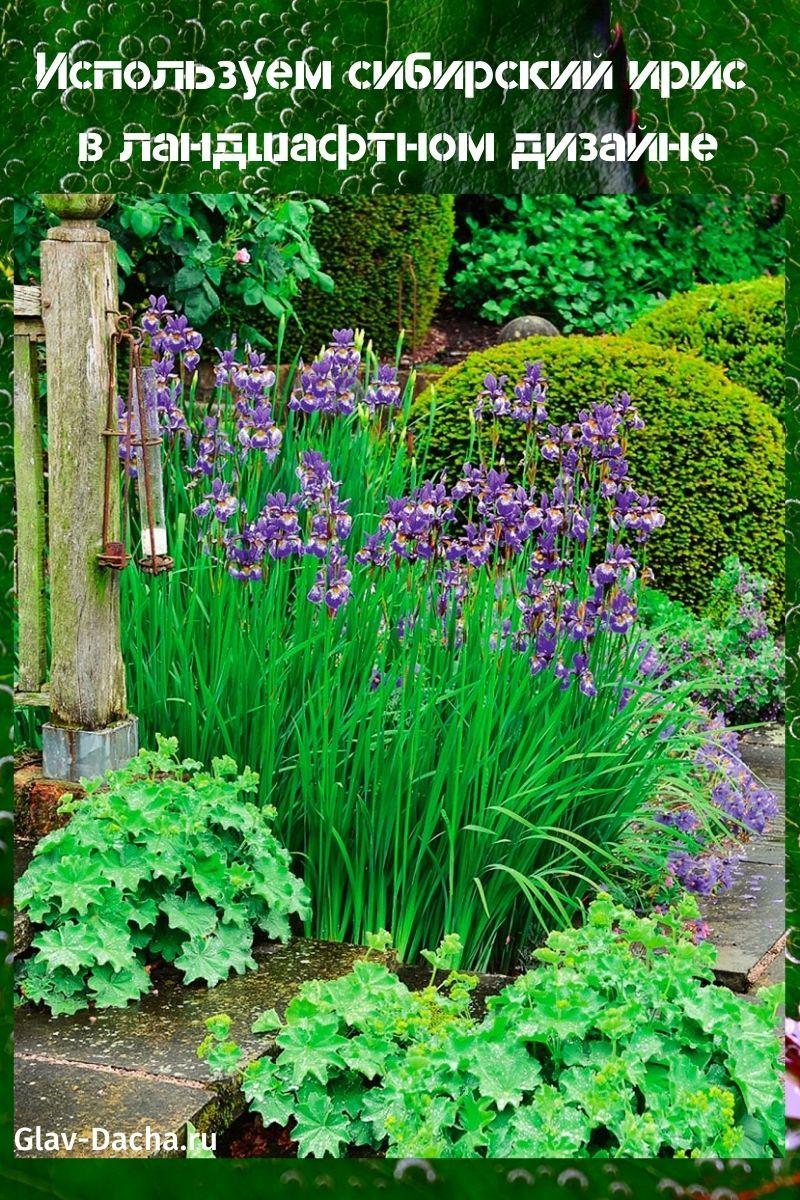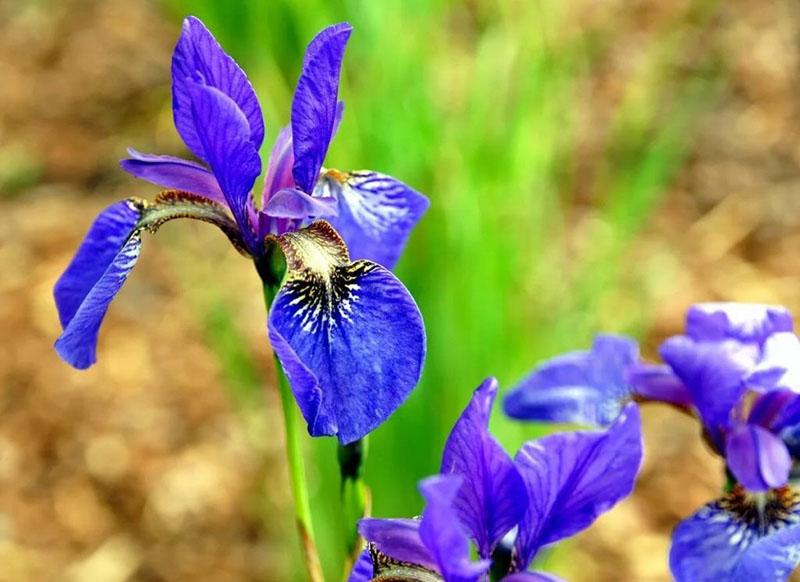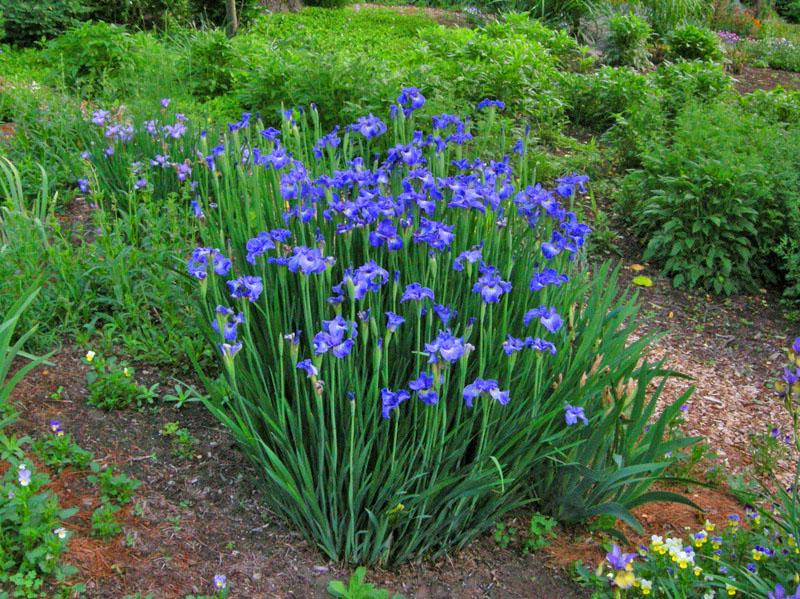We use Siberian iris in landscape design
 Siberian iris is a real decoration of any flower garden, combining ease of planting, unpretentious care and luxurious appearance. Siberian iris in landscape design is used to create lush flower beds, decorate fences and hedges, and decorate borders. A beautiful and bright plant can be grown even in the absence of horticultural experience, and a huge variety of Siberian irises will delight any grower.
Siberian iris is a real decoration of any flower garden, combining ease of planting, unpretentious care and luxurious appearance. Siberian iris in landscape design is used to create lush flower beds, decorate fences and hedges, and decorate borders. A beautiful and bright plant can be grown even in the absence of horticultural experience, and a huge variety of Siberian irises will delight any grower.
General description of Siberian irises


Main features of Siberian iris:
- Superficial and highly branched root system, giving an abundance of filamentous root growth.
- The stem is erect or branched, up to 80-110 cm high.
- Leaves are linear, narrowed, 4-6 cm wide and up to 70-80 cm long. The leaf plate is soft, dark green in color, with a pointed upper part and smooth edges.
- The diameter of flower buds is up to 7 cm, they are located at the very top of the peduncle. The bracts have a drooping, slightly oval shape, the petals in the center are erect.
- The color depends on the Siberian iris variety. Most often, flower petals are blue, purple or lilac with yellow or snow-white blotches on the base.
A characteristic feature of Siberian irises is the formation of a large number of flowers - up to 30-40 buds per plant.
Most varieties bloom in May or June. In this case, the flowering period usually does not exceed 20 days, and the "lifespan" of one bud is up to 6 days.
Popular varieties of Siberian iris
 To date, about 800 varieties of Siberian irises have been bred, among which are tall and dwarf species, with double or simple flowers.
To date, about 800 varieties of Siberian irises have been bred, among which are tall and dwarf species, with double or simple flowers.
The most common varieties of Siberian iris:
- Harpswell Hayes is an unpretentious and viable plant, up to 90 cm high, with large purple flowers up to 14 cm in diameter.

- Snow Queen (Snow Queen) is a rare variety up to 100 cm in height, having flowers of an unusual snow-white color with yellow veins up to 10 cm in diameter. Up to 50 buds are formed on one plant.

- White Swirl is a tall variety, reaching 110 cm. Inflorescences are creamy yellow, streaked with lemon shade.

The violet-lavender Ruffled Plus, the blue Leader of Altai, the yellow Iris, the violet-purple Hubbard are considered no less famous and popular varieties.




Growing Siberian iris
 Planting and caring for Siberian iris is not particularly difficult; this frost-resistant and unpretentious plant blooms magnificently in any climatic conditions. But this flower is very fond of light, therefore, for its cultivation and abundant flowering, you need to choose only sunny, brightly lit areas.
Planting and caring for Siberian iris is not particularly difficult; this frost-resistant and unpretentious plant blooms magnificently in any climatic conditions. But this flower is very fond of light, therefore, for its cultivation and abundant flowering, you need to choose only sunny, brightly lit areas.
Siberian iris has no special requirements for the quality of the soil on the site. The only conditions are good drainage and slightly acidic soil acidity. They grow well on loamy soils, as well as areas with high groundwater levels, unsuitable for growing other ornamental plants.
 Planting of Siberian iris in spring is carried out in late March or April, in autumn - in September. Before planting work, dig up the soil on the site and apply organic (compost or humus) or complex mineral fertilizers.
Planting of Siberian iris in spring is carried out in late March or April, in autumn - in September. Before planting work, dig up the soil on the site and apply organic (compost or humus) or complex mineral fertilizers.
For growing Siberian iris, it is best to use seedlings purchased from specialized nurseries.
Before planting, carefully inspect them - there should be no traces of rot, fungi or mold on the cut on the surface, and the structure of the seedling should be dense and elastic.
 Before planting Siberian iris, you need to prepare the seedlings. To do this, cut the roots by 11-13 cm, leave about 1/3 of the length at the leaves. In no case should you add lime to the soil before planting the iris, since the flower needs a slightly acidic soil.
Before planting Siberian iris, you need to prepare the seedlings. To do this, cut the roots by 11-13 cm, leave about 1/3 of the length at the leaves. In no case should you add lime to the soil before planting the iris, since the flower needs a slightly acidic soil.
 Prepare the planting holes and lower the seedling into them, deepening the root collar by 5-7 cm. Sprinkle the hole with soil, water abundantly and mulch. Keep the distance between the planting holes 30-40 cm.
Prepare the planting holes and lower the seedling into them, deepening the root collar by 5-7 cm. Sprinkle the hole with soil, water abundantly and mulch. Keep the distance between the planting holes 30-40 cm.
Siberian iris care
Siberian iris care is very simple and consists of minimal agronomic measures. Young seedlings need regular watering and top dressing, adult plants need pruning and transplanting.
Watering
 After planting, young seedlings require abundant and regular watering to help them take root. After some time, the root system of the flower grows and it can easily tolerate a lack of moisture.
After planting, young seedlings require abundant and regular watering to help them take root. After some time, the root system of the flower grows and it can easily tolerate a lack of moisture.
Water rarely for adult irises, but in case of prolonged drought, be sure to increase the amount of moisture. In this case, irrigation should be rare, but abundant - to moisten the soil to the entire depth of the root system.
Iris should be watered in the early morning or evening after sunset. During moisturizing, care must be taken to ensure that no water gets directly onto the flower buds - this negatively affects their appearance.
Top dressing
 For a long and lush flowering of Siberian irises, already in the second year after planting, they can be fed with organic (manure, compost, herbal infusions) or complex mineral fertilizers. They are applied in early spring, and in wet and damp weather - by foliar feeding.
For a long and lush flowering of Siberian irises, already in the second year after planting, they can be fed with organic (manure, compost, herbal infusions) or complex mineral fertilizers. They are applied in early spring, and in wet and damp weather - by foliar feeding.
During the period of peduncle formation or after the end of flowering, it is advisable to re-feed Siberian irises with complex mineral fertilizers. Their composition should be dominated by potassium and phosphorus with a small concentration of nitrogen.
Pruning
 After flowering, Siberian iris needs pruning. During this procedure, wilted inflorescences are removed along with the seed pods. Without pruning, the seeds will fall to the surface of the ground and germinate in weak, thin shoots in the spring.
After flowering, Siberian iris needs pruning. During this procedure, wilted inflorescences are removed along with the seed pods. Without pruning, the seeds will fall to the surface of the ground and germinate in weak, thin shoots in the spring.
In October or early November, the entire aerial part of the Siberian iris should be cut off. If this is not done, fragile young shoots will not be able to break through the dense deciduous soil in the spring.
Preparing for winter
 Preparation of irises for winter begins 1-2 weeks before the first frost. First of all, you need to cut off old and dry leaves to a height of 15 cm.
Preparation of irises for winter begins 1-2 weeks before the first frost. First of all, you need to cut off old and dry leaves to a height of 15 cm.
To increase the frost resistance of the plant, it must be mulched. For this purpose, compost or humus, chopped bark, sawdust or spruce branches are best suited.
Siberian iris in landscape design
 The use of Siberian iris in landscape design depends on the variety and color of the plant. Almost all varieties go well with conifers, ornamental shrubs.
The use of Siberian iris in landscape design depends on the variety and color of the plant. Almost all varieties go well with conifers, ornamental shrubs.
Interesting options for using Siberian iris in landscape design:
- delimitation of several landscape zones;
- registration of the banks of artificial reservoirs;

- decoration of slopes and prevention of their shedding;
- arrangement of mixborders with other decorative crops;

- decorating garden paths and rockeries;

- decoration of fences and hedges;
- tamping the edge of the lawn;

- decorating rock gardens;
- constituent element in mass plantings to fill empty areas.
Tall species with a classic blue-violet color and simple flower shape look great in the center of an island flower bed or in the background of a mixborder. For the foreground, Siberian iris varieties with cup-shaped, double inflorescences are more suitable.
Bright and sophisticated Siberian irises are often used to decorate a pond in a personal plot. Slender plants blend harmoniously with coastal plantations.
Siberian irises in garden design can be used to decorate large rockeries... In such cases, both a group planting and several individual plants planted as bright vertical accents will look spectacular.
 Siberian iris is a beautiful and unpretentious plant that will decorate any garden area with bright and lush inflorescences. The flower is highly resistant to diseases and adverse weather conditions. Caring for him will take a minimum of time. Subject to simple and light agricultural techniques, Siberian iris will become a magnificent element of landscape design.
Siberian iris is a beautiful and unpretentious plant that will decorate any garden area with bright and lush inflorescences. The flower is highly resistant to diseases and adverse weather conditions. Caring for him will take a minimum of time. Subject to simple and light agricultural techniques, Siberian iris will become a magnificent element of landscape design.